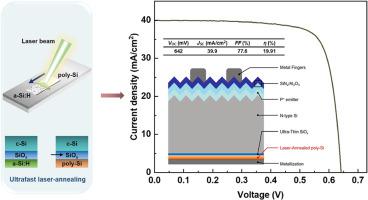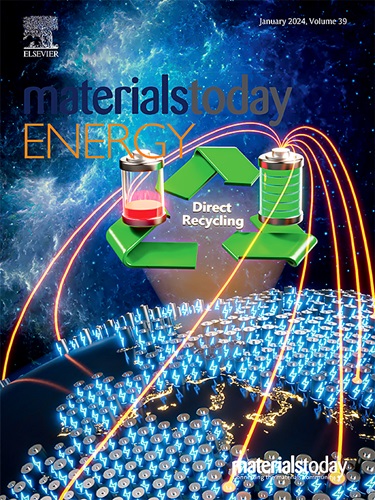在用于高效 n 型硅太阳能电池的隧道氧化物钝化触点中对氢化非晶硅进行超快激光退火
IF 8.6
2区 材料科学
Q1 CHEMISTRY, PHYSICAL
引用次数: 0
摘要
在过去几年里,隧道氧化物钝化接触(TOPCon)概念一直是新兴钝化接触技术领域最耀眼的明星。由于具有器件效率高、成本低等压倒性优势,它在工业应用中显示出巨大的潜力。在此,我们介绍了一种新型结晶方法,即在 TOPCon 太阳能电池的氢化非晶硅薄膜表面扫描激光光斑,利用超快激光退火技术进行结晶。这种方法避开了传统退火工艺的高温环境,可防止大量掺杂原子渗入晶体硅(c-Si)衬底内部,从而减少奥杰尔重组。此外,我们还可以通过大量实验来明确最佳条件,包括激光退火模式和工艺参数。氢化实验表明,直接采用传统的氢化方法并不适用。额外的 "脱氢 "步骤证明是必要的,这表明由于激光退火和高温退火的原理不同,薄膜中氢含量的差异可能是造成这种情况的原因。因此,采用激光退火技术的概念验证装置的冠军效率达到了 19.91%,这突出表明了实现高效晶体硅太阳能电池的另一条具有巨大潜力的技术路线。本文章由计算机程序翻译,如有差异,请以英文原文为准。

Ultrafast laser-annealing of hydrogenated amorphous silicon in tunnel oxide passivated contacts for high-efficiency n-type silicon solar cells
The tunnel oxide passivated contact (TOPCon) concept has been the brightest star in the field of emerging passivating contact techniques for the last few years. It has shown great potential in industrial applications due to the overwhelming advantages of high device efficiency and low cost. Here, we introduce a novel crystallization method using ultrafast laser-annealing by scanning a laser spot onto the surface of hydrogenated amorphous silicon film in TOPCon solar cells. By circumventing the high-temperature environment of the conventional annealing process, it can prevent a large number of dopant atoms from penetrating inside the crystalline silicon (c-Si) substrate, reducing the Auger recombination. Moreover, we can conduct extensive experiments to clarify the optimal conditions, including laser-annealing modes and process parameters. The hydrogenation experiments reveal that direct appropriation of the traditional hydrogenation method is not applicable. An additional ‘dehydrogenation’ step proves necessary, indicating that the differences in hydrogen content within the films due to the divergence between the principles of laser-annealing and high-temperature annealing are probably responsible for this. Consequently, the proof-of-concept devices using laser-annealing technology realize a champion efficiency of 19.91%,highlighting an alternative technical route with substantial potential to achieve high-efficiency crystalline silicon solar cells.
求助全文
通过发布文献求助,成功后即可免费获取论文全文。
去求助
来源期刊

Materials Today Energy
Materials Science-Materials Science (miscellaneous)
CiteScore
15.10
自引率
7.50%
发文量
291
审稿时长
15 days
期刊介绍:
Materials Today Energy is a multi-disciplinary, rapid-publication journal focused on all aspects of materials for energy.
Materials Today Energy provides a forum for the discussion of high quality research that is helping define the inclusive, growing field of energy materials.
Part of the Materials Today family, Materials Today Energy offers authors rigorous peer review, rapid decisions, and high visibility. The editors welcome comprehensive articles, short communications and reviews on both theoretical and experimental work in relation to energy harvesting, conversion, storage and distribution, on topics including but not limited to:
-Solar energy conversion
-Hydrogen generation
-Photocatalysis
-Thermoelectric materials and devices
-Materials for nuclear energy applications
-Materials for Energy Storage
-Environment protection
-Sustainable and green materials
 求助内容:
求助内容: 应助结果提醒方式:
应助结果提醒方式:


